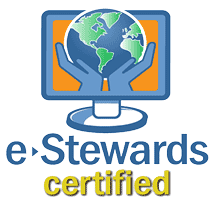My school just had our annual Discovery Night - a night were students celebrate their learning and display their expertise to parents, friends, staff, and guests. Our classroom's topic this year was electronic waste and its impact both socially and environmentally. It began with a unit on the periodic table, elements, and how elements are in the everyday electronics we use every day.
Students had been learning about this for the past quarter. The more they learned, the more engaged they became. It started with "wow, there is gold in my cell phone?" to "wow, I didn't realize how much stuff was made - they sure need a lot of copper!" and ended with "we really need to do something about this." Students became aware of the environmental impact of creating and disposing all of these devices and how regions have been devastated due to mass consumerism. They also were made aware of the social impact and how poorer countries tend to get our used junk.
One of many photos and videos we saw about this issue
Students were divided into five groups and assigned a specific type of electronic: computers, monitors, phones, printers, and televisions. Each group did research about their specific device and the dangers presented by recycling, trashing, or burning it. Students came up with amazing facts to help quantify the amount of e-waste generated each year. For instance, did you know that about 150 million mobile devices will be disposed of this year? This means that if you placed the disposed phones down end to end, they would stretch almost half way around Earth!
Facts like that really got the adults' attention.
The presentation was set up in a
what - so what - now what format. Students explained what e-waste was, used facts like the ones above to explain why we should care, and then described a plan that their group designed to help impact the problem.
Only one group would be able to move on.
Originally the students plan was just"recycle" their items, but they found two major problems with that. First, it didn't take into consideration the consumerism issue. Recycling is great, but buying less will vastly reduce the amount of e-waste being produced. Secondly, we found that recycling doesn't always mean what we think it means. We learned is that even when you "recycle" electronics, there is about an 80% chance that the device will be shipped overseas where it will be dismantled and burned for precious metals. Places like Ghana, China, and Indonesia have areas that have become e-wastelands, and their proposals had to make sure this wouldn't happen.
That is when they learned about recycling certification, and found different locations that have one of the two major certifications: R2 certified, or E-steward certified. They decided any proposal that used recycling had to include places that were certified.
The big night came - parents were given score sheets and were asked to evaluate each group's project. We explained that the group with the highest overall score would come to life. Our class wasn't just going to come up with ideas - we were going to take action!
Five groups - five proposals - one winner. Here is an outline of all five:
Delete E-waste: Students in this group want to write the Ohio Senate and House to pass legislation to require citizens to bring electronics to certified e-waste facilities. This proposal includes ideas such as tax incentives for bringing items to certified locations, or for locations to become e-waste certified.
Time to Monitor Our E-waste: This group decided to create a teen-friendly PSA which will inform people about the dangers and causes of e-waste. Specifically they would talk to the audience about "do you REALLY NEED a new phone? why not hold off..." to try and target a reduction in consumerism. They would post this on social media as well as the school website.
Earth's Last Call: Earth's Last Call want to go right to the source - talk to CEOs and designers about using sustainable materials in the production stage. Their angle: sustainability is the new buzz word - just like organic was once only available at specialty stores, but now available everywhere, consumers are starting to become more aware of their impact. As such, designers and companies should corner the market on sustainable equipment because this is the future of technology!
Running Low on Resources: Students in this group want to do a social media blitz to encourage recycling all of the old electronics that are sitting around their homes. Their plan - take a selfie of yourself recycling an electronic at a certified e-waste location (such as Staples). Then upload the picture on social media with the hashtag #SaveTheBigBlueMarble. From there, tag three people and challenge them to recycle at least one item at a certified location!
E-Waste Channel: This group wanted to create a video and post it on social media. The idea behind this video would be educating people on what e-waste is and why it is a growing problem, focusing on sustainability. The video would be presented to students at our school as well as posted on social media.
The adults voted, tabulated, and checked for accuracy. I will announce the winner this week! In the mean time, which group would you vote for?
Place votes in the CD-ROM slot, please












